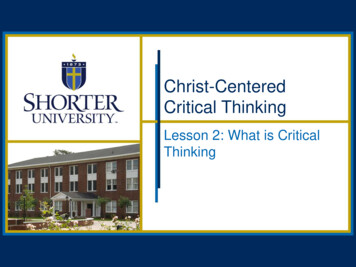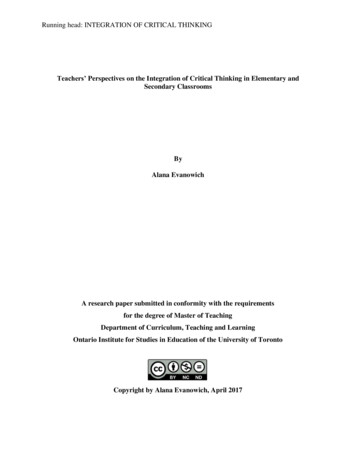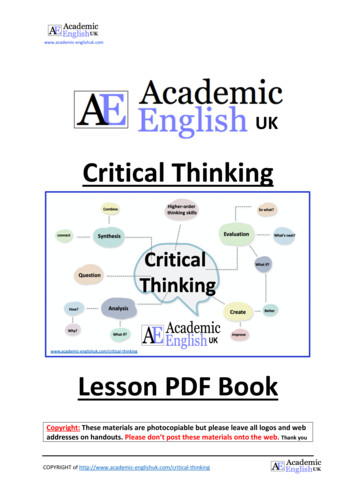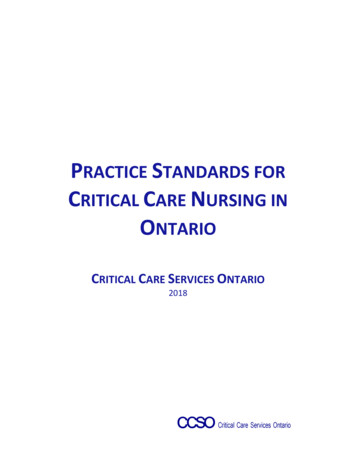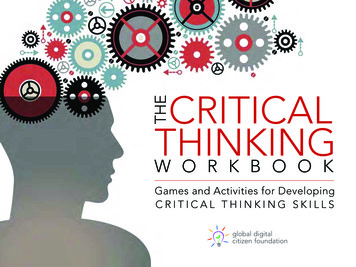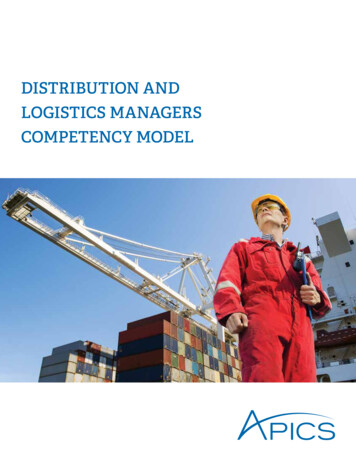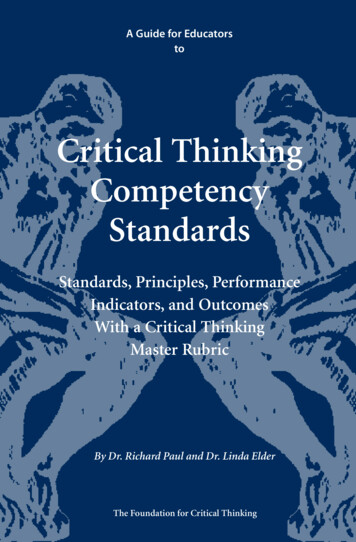
Transcription
limited preview versionA Guide for EducatorstoCritical ThinkingCompetencyStandardsStandards, Principles, PerformanceIndicators, and OutcomesWith a Critical ThinkingMaster RubricBy Dr. Richard Paul and Dr. Linda ElderThe Foundation for Critical Thinking 2007 Foundation for Critical Thinking Presswww.criticalthinking.org
limited preview versionCritical Thinking Competency Standards Letter to the ReaderMuch lip service is given to the notion that students are learning to think critically. Acursory examination of critical thinking competency standards (enumerated and elaborated in this guide) should persuade any reasonable person familiar with schooling todaythat they are not. On the other hand, a reasonable person might also conclude that noteacher in any single subject could teach all of these standards. We agree.The critical thinking competency standards articulated in this guide serve as a resourcefor teachers, curriculum designers, administrators and accrediting bodies. The use ofthese competencies across the curriculum will ensure that critical thinking is fostered inthe teaching of any subject to all students at every grade level. We can expect large groupsof students to achieve these competencies only when most teachers within a particularinstitution are fostering critical thinking standards in their subject(s) at their grade level.We cannot expect students to learn critical thinking at any substantive level through one ora few semesters of instruction.Viewed as a process covering twelve to sixteen years and beyond, and contributed to byall instruction, both at the K-12 as well as the college and university level, all of the competencies we articulate, and more, can be achieved by students. We recommend thereforethat those responsible for instruction identify which competencies will be fostered at whatgrade level in what subjects for what students. The most important competencies must bereinforced within most instruction. Some competencies might well be taught in a morerestricted way.We believe any well-educated student or citizen needs the abilities and dispositions fostered through these competencies. We also believe that any reasonable person who closelystudies these competencies will agree.To transform classrooms into communities of thinkers, we need to take a long-termview. We need to reflect widely and broadly. We need to be systematic, committed, andvisionary. The task is challenging indeed. But it is a challenge we ignore at the risk of thewell-being of our students and that of our society.Linda ElderFoundation for Critical Thinking 2007 Foundation for Critical Thinking PressRichard PaulCenter for Critical Thinkingwww.criticalthinking.org
limited preview versionCritical Thinking Competency StandardsContentsIntroductionThe Structure of This Guide . . . . . . . . . . . . . . . . . . . . . . . . . . . . . . . . . . . . . . . . . . . . . . . . . 4Understanding the Intimate Relationship BetweenCritical Thinking, Learning, and EducationThe Concept of Critical Thinking . . . . . . . . . . . . . . . . . . . . . . . . . . . . . . . . . . . . . . . . . . . . . 6The What and the How of Education . . . . . . . . . . . . . . . . . . . . . . . . . . . . . . . . . . . . . . . . . 6Critical Thinking is the “How” for Obtaining Every Educational “What” . . . . . . . . . 7Critical Thinking and Learning . . . . . . . . . . . . . . . . . . . . . . . . . . . . . . . . . . . . . . . . . . . . . . . 8Critical Thinking and the Educated Person . . . . . . . . . . . . . . . . . . . . . . . . . . . . . . . . . . . 9Critical Thinking and Information Literacy . . . . . . . . . . . . . . . . . . . . . . . . . . . . . . . . . . . 9The Growing Importance of Critical Thinking . . . . . . . . . . . . . . . . . . . . . . . . . . . . . . . . 0Critical and Creative Thinking . . . . . . . . . . . . . . . . . . . . . . . . . . . . . . . . . . . . . . . . . . . . . . Critical Thinking and the Mastery of Content . . . . . . . . . . . . . . . . . . . . . . . . . . . . . . . . Adapting the Standards in Particular Subjects . . . . . . . . . . . . . . . . . . . . . . . . . . . . . . . 3The Structure and Components of the CompetenciesRelating the Competencies to Critical Thinking Concepts . . . . . . . . . . . . . . . . . . . . 4Outlining the Components in Each Competency . . . . . . . . . . . . . . . . . . . . . . . . . . . . 4A Master Rubric . . . . . . . . . . . . . . . . . . . . . . . . . . . . . . . . . . . . . . . . . . . . . . . . . . . . . . . . . . . 6The Critical Thinking CompetenciesStandard One: Purposes, Goals, and Objectives . . . . . . . . . . . . . . . . . . . . . . . . . . . . . . . . . . . . . . . . . . . . . . 17Standard Two: Questions, Problems, and Issues . . . . . . . . . . . . . . . . . . . . . . . . . . . . . . . . . . . . . . . . . . . . . . 18Standard Three: Information, Data, Evidence, and Experience . . . . . . . . . . . . . . . . . . . . . . . . . . . . . . . . . . . 19Standard Four: Inferences and Interpretations . . . . . . . . . . . . . . . . . . . . . . . . . . . . . . . . . . . . . . . . . . . . . . . 20Standard Five: Assumptions & Presuppositions . . . . . . . . . . . . . . . . . . . . . . . . . . . . . . . . . . . . . . . . . . . . . . 20Standard Six: Concepts, Theories, Principles, Definitions, Laws, & Axioms . . . . . . . . . . . . . . . . . . . . . . . . . 21Standard Seven: Implications and Consequences . . . . . . . . . . . . . . . . . . . . . . . . . . . . . . . . . . . . . . . . . . . . . 22Standard Eight: Points of View and Frames of Reference . . . . . . . . . . . . . . . . . . . . . . . . . . . . . . . . . . . . . . . 23Standard Nine: Assessing Thinking . . . . . . . . . . . . . . . . . . . . . . . . . . . . . . . . . . . . . . . . . . . . . . . . . . . . . . . . . 25Standard Ten: Fairmindedness . . . . . . . . . . . . . . . . . . . . . . . . . . . . . . . . . . . . . . . . . . . . . . . . . . . . . . . . . . . . 26Standard Eleven: Intellectual Humility . . . . . . . . . . . . . . . . . . . . . . . . . . . . . . . . . . . . . . . . . . . . . . . . . . . . . . 27Standard Twelve: Intellectual Courage . . . . . . . . . . . . . . . . . . . . . . . . . . . . . . . . . . . . . . . . . . . . . . . . . . . . . . 28Standard Thirteen: Intellectual Empathy . . . . . . . . . . . . . . . . . . . . . . . . . . . . . . . . . . . . . . . . . . . . . . . . . . . . 29Standard Fourteen: Intellectual Integrity . . . . . . . . . . . . . . . . . . . . . . . . . . . . . . . . . . . . . . . . . . . . . . . . . . . 30Standard Fifteen: Intellectual Perseverance . . . . . . . . . . . . . . . . . . . . . . . . . . . . . . . . . . . . . . . . . . . . . . . . . 30 2007 Foundation for Critical Thinking Presswww.criticalthinking.org
limited preview versionCritical Thinking Competency StandardsStandard Sixteen: Confidence in Reason . . . . . . . . . . . . . . . . . . . . . . . . . . . . . . . . . . . . . . . . . . . . . . . . . . . . 31Standard Seventeen: Intellectual Autonomy . . . . . . . . . . . . . . . . . . . . . . . . . . . . . . . . . . . . . . . . . . . . . . . . . 32Standard Eighteen: Insight into egocentricity . . . . . . . . . . . . . . . . . . . . . . . . . . . . . . . . . . . . . . . . . . . . . . . . 33Standard Nineteen: Insight into sociocentricity . . . . . . . . . . . . . . . . . . . . . . . . . . . . . . . . . . . . . . . . . . . . . . . 34Standard Twenty: Skills in the Art of Studying and Learning . . . . . . . . . . . . . . . . . . . . . . . . . . . . . . . . . . . 35Standard Twenty-One: Skills in the Art of Asking Essential Questions . . . . . . . . . . . . . . . . . . . . . . . . . . . . 36Standard Twenty-Two: Skills in the Art of Close Reading . . . . . . . . . . . . . . . . . . . . . . . . . . . . . . . . . . . . . . . 38Standard Twenty-Three: Skills in the Art of Substantive Writing . . . . . . . . . . . . . . . . . . . . . . . . . . . . . . . . . 39Standard Twenty-Four: Ethical Reasoning Abilities . . . . . . . . . . . . . . . . . . . . . . . . . . . . . . . . . . . . . . . . . . . 40Standard Twenty-Five: Skills in Detecting Media Bias andPropaganda in National and World News . . . . . . . . . . . . . . . . . . . . . . . . . . . . . . . . . . . . . . . . . . . . . . . . 43Appendix: Critical Thinking Theory Underlying the CompetenciesAll thinking can be analyzed by identifying its eight elements . . . . . . . . . . . . . . 47All thinking must be assessed for quality using universalintellectual standards . . . . . . . . . . . . . . . . . . . . . . . . . . . . . . . . . . . . . . . . . . . . . . . . . . 49The ultimate goal of critical thinking is to foster the developmentof intellectual traits or dispositions (and the skills and abilitiesthey presuppose .) . . . . . . . . . . . . . . . . . . . . . . . . . . . . . . . . . . . . . . . . . . . . . . . . . . . . . . 50Egocentrism and Sociocentrism, Natural Predispositions of the Mindand Powerful Barriers to the Dvelopment of Thinking . . . . . . . . . . . . . . . . . . . . 5 Deepening Your Understanding of the Critical Thinking Competencies . . . . . . 54 2007 Foundation for Critical Thinking Presswww.criticalthinking.org3
limited preview versionCritical Thinking Competency Standards5play in education, if we are ever to foster the skills of mind necessary for functioning effectively in an increasingly complex world.After a brief discussion of critical thinking and its relationship to education, we outlineand detail the competencies, relate them to seminal critical thinking concepts, and thenprovide rubrics for scoring. In the appendix we provide a brief overview of the theoryunderlying the competencies.It is important to note that, only when teachers understand the foundations of criticalthinking can they effectively teach for it. This fact should become clearer as you workthrough the competencies.Throughout the guide (including the appendix), we recommend readings, readings thatlay the groundwork for understanding and fostering the competencies. Before attemptingto foster any particular competency, or set of competencies, we recommend that teachers spend time internalizing the related critical thinking concepts we reference for eachcompetency.The simple truth is that teachers are able to foster critical thinking only to the extentthat they themselves think critically. This may be the single most significant barrier tostudent achievement of critical thinking competencies. For teachers to aid students inbecoming deep thinkers, they must themselves think deeply. For teachers to aid students indeveloping intellectual humility, they must themselves have developed intellectual humility.For teachers to foster a reasonable, rational multi-logical worldview, they must themselveshave developed such a worldview. In short, teaching for critical thinking presupposes aclear conception of critical thinking in the mind of the teacher.Unfortunately, we cannot assume that teachers have a clear concept of critical thinking.Indeed, research indicates that the opposite is true. Available evidence suggests that critical thinking is rarely fostered in a systematic way in academic programs at any level. Theinstitutions most effectively able to use critical thinking competencies are those guidedby leaders who themselves understand critical thinking, and who support an effective longterm staff development program in critical thinking.1 For two related articles on long-term staff development designed to foster a substantive concept of criticalthinking, see the following links: org/resources/articles/the-state-ct-today.shtml Though these articles focusspecifically on staff development in higher education, the same basic approach would apply to K- 2 schooling 2007 Foundation for Critical Thinking Presswww.criticalthinking.org
6limited preview versionCritical Thinking Competency StandardsUnderstanding the IntimateRelationship Between Critical Thinking,Learning, and EducationLet us begin by focusing some attention on the intimate relationships between criticalthinking, learning and education. Only when teachers understand these relationships willthey see the importance of placing critical thinking at the heart of instruction.The Concept of Critical Thinking The concept of critical thinking can be expressed in a variety of definitions, depending on one’s purpose (though, as with every concept, its essence is always the same). Thedefinition most useful in assessing critical thinking abilities is as follows:Critical thinking is the process of analyzing and assessing thinking with a view toimproving it. Critical thinking presupposes knowledge of the most basic structures inthinking (the elements of thought) and the most basic intellectual standards for thinking (universal intellectual standards). The key to the creative side of critical thinking(the actual improving of thought) is in restructuring thinking as a result of analyzingand effectively assessing it.As teachers foster critical thinking skills, it is important that they do so with theultimate purpose of fostering traits of mind. Intellectual traits or dispositions distinguish askilled but sophistic thinker from a skilled fair-minded thinker. Fairminded critical thinkers are intellectually humble and intellectually empathic. They have confidence in reasonand intellectual integrity. They display intellectual courage and intellectual autonomy.It is possible to develop some critical thinking skills within one or more content areaswithout developing critical thinking skills in general. The best teaching approach fostersboth, so that students learn to reason well across a wide range of subjects and domains.The “What” and the “How” of EducationThe “what” of education is the content we want students to acquire, everything we wantstudents to learn. The “how” of education is the process, everything we do to help studentsacquire the content in a deep and meaningful way.Most teachers assume that if they expose students to the “what,” students will automatically use the proper “how.” This common, yet false, assumption is, and has been for manyyears, a plague on education. By focusing on “content coverage,” rather than on learninghow to learn, schooling has failed to teach students how to take command of their learning,how to bring ideas into the mind using the mind, how to interrelate ideas within and2 For an overview of the concept of critical thinking, see the Miniature Guide to Critical Thinking Conceptsand Tools, by Richard Paul and Linda Elder, 2004. Dillon Beach: Foundation for Critical Thinking, www.criticalthinking.org. 2007 Foundation for Critical Thinking Presswww.criticalthinking.org
limited preview versionCritical Thinking Competency Standards7among disciplines. Most teachers devise instructional methods based on the followingassumptions:1. Lecture content can be absorbed with minimal intellectual engagement on the part ofstudents.2. Students can learn important content without much intellectual work.3. Memorization is the key to learning, so that students need to store up lots of information (that they can use later when they need it).Critical Thinking is the “How” for Obtaining EveryEducational “What”As we have already mentioned, a significant barrier to the development of student thinkingis the fact that few teachers understand the concept or importance of intellect engagementin learning. Having been taught by instructors who primarily lectured, many teachers teachas if ideas and thoughts could be poured into the mind without the mind having to dointellectual work to acquire them.To enable students to become effective learners, teachers must learn what intellectualwork looks like, how the mind functions when it is intellectually engaged, what it means totake ideas seriously, to take ownership of ideas.3To do this, teachers must understand the essential role of thinking in the acquisition ofknowledge. Pestalozzi puts it this way:Thinking leads man to knowledge. He may see and hear and read and learn whatever hepleases, and as much as he pleases; he will never know anything of it, except that whichhe has thought over, that which by thinking he has made the property of his own mind.John Henry Newman, more than 150 years ago, described this process as follows:[The process] consists, not merely in the passive reception into the mind of a number ofideas hitherto unknown to it, but in the mind’s energetic and simultaneous action uponand towards and among those new ideas, which are rushing in upon it. It is the action ofa formative power, reducing to order and meaning the matter of our acquirements; it isa making the objects of our knowledge subjectively our own, or, to use a familiar word,it is a digestion of what we receive, into the substance of our previous state of thought;and without this no enlargement is said to follow. There is no enlargement, unless therebe a comparison of ideas one with another, as they come before the mind, and a systematizing of them. We feel our minds to be growing and expanding then, when we not onlylearn, but refer what we learn to what we know already. It is not the mere addition to ourknowledge that is the illumination; but the locomotion, the movement onwards, of thatmental centre, to which both what we know, and what we are learning, the accumulatingmass of our acquirements, gravitates. For instructional strategies designed to foster critical thinking see The Miniature Guide on How to ImproveStudent Learning: 0 Practical Ideas, by Richard Paul and Linda Elder, 2004. Dillon Beach: Foundation for CriticalThinking, www.criticalthinking.org. See also The Miniature Guide on Active and Cooperative Learning, byWesley Hiler and Richard Paul, 2002, Dillon Beach: Foundation for Critical Thinking, www.criticalthinking.org.4 Newman, J. ( 852) The Idea of a University 2007 Foundation for Critical Thinking Presswww.criticalthinking.org
8limited preview versionCritical Thinking Competency StandardsCritical thinking is the set of intellectual skills, abilities and dispositions characterized by Newman in this passage. It leads to content mastery and deep learning. It developsappreciation for reason and evidence. It encourages students to discover and process information, and to do so with discipline. It teaches students to think their way to conclusions,defend positions on complex issues, consider a wide variety of viewpoints, analyze concepts, theories, and explanations, clarify issues and conclusions, solve problems, transferideas to new contexts, examine assumptions, assess alleged facts, explore implications andconsequences, and increasingly come to terms with the contradictions and inconsistencies in their own thought and experience. This is the thinking, and alone the thinking, thatmasters content.Thought and content are inseparable, not antagonists but partners. There is no suchthing as thinking about nothing. When we think about nothing we are not thinking.Thinking requires content, substance, something to think through. On the other hand,content is parasitic upon thinking. It is discovered and created by thought, analyzed andsynthesized by thought, organized and transformed by thought, accepted or rejected bythought.To teach content separate from thinking is to ensure that students never learn to thinkwithin the discipline (that defines and creates the content). It is to substitute the mere illusion of knowledge for genuine knowledge. It is to deny students the opportunity to becomeself-directed, motivated, lifelong learners.Critical Thinking and LearningThe key insight into the connection of learning to critical thinking is this:The only capacity we can use to learn is human thinking. If we think well while learning, we learn well. If we think poorly while learning, we learn poorly.To learn a body of content, say, an academic discipline, is equivalent to learning to thinkwithin the discipline. Hence to learn biology, one has to learn to think biologically. Tolearn sociology, one has to learn to think sociologically.If we want to develop rubrics for learning in general, they should be expressed in termsof the thinking one must do to succeed in the learning. Students need to think critically tolearn at every level. Sometimes the critical thinking required is elementary and foundational. For example, in studying a subject there are foundational concepts that define thecore of the discipline. To begin to take ownership one needs to give voice to those basicconcepts—e.g. to state what the concept means in one’s own words; to elaborate what theconcept means, again in one’s own words; and then to give examples of the concept fromreal-life situations.Without critical thinking guiding the process of learning, rote memorization becomesthe primary recourse, with students forgetting at about the same rate they are learning andrarely, if ever, internalizing powerful ideas. For example, most students never take genuineownership of the concept of democracy. They memorize phrases like, “a democracy isgovernment of the people, by the people, for the people.” But they don’t come to understand 2007 Foundation for Critical Thinking Presswww.criticalthinking.org
limited preview versionCritical Thinking Competency Standards9what such a definition means. And when they don’t know what a definition means, theycannot elaborate or exemplify its meaning.Moreover, most students are unable to distinguish between democracy and otherforms of government incompatible with democracy, like, say, plutocracy. They don’t trulyunderstand the concept of democracy because they have never worked the idea into theirthinking, comparing it with other forms of government, considering the conditions withina society that would have to exist for a democracy to work, assessing practices in their owncountry to determined for themselves whether a true democracy exists, and, if not, howconditions would have to change for a democracy to be realized.Through critical thinking, then, we are able to acquire knowledge, understanding,insights, and skills in any given body of content. To learn content we must think analytically and evaluatively within that content. Thus critical thinking provides tools for bothinternalizing content (taking ownership of content) and assessing the quality of that internalization. It enables us to construct the system (that underlies the content) in our minds,to internalize it, and to use it reasoning through actual problems and issues.Critical Thinking and the Educated PersonDeveloping critical thinkers is central to the mission of all educational institutions. Byensuring that students learn to think critically and fairmindedly, we ensure that studentsnot only master essential subject matter, but become effective citizens, capable of reasoningethically and acting in the public good. To successfully teach critical thinking, it must bewoven into curriculum content, structure, and sequence at all grade levels.Education, properly so called, alters and reworks the mind of the student. Educatedpersons function differently from uneducated persons. They are able to enter and intellectually empathize with alternate ways of looking at things. They change their minds whenevidence or reasoning require it. They are able to internalize important concepts within adiscipline and interrelate those concepts with other important concepts both within andamong disciplines. They are able to reason well enough to think their way through complexproblems. If students are to become educated persons, teachers must place thinking at theheart of the curriculum; they must require students to actively work ideas into their thinking using their thinking.Critical Thinking and Information LiteracyInformation literacy is of growing concern to educators. It involves a constellation of skillslinked both to education and to critical thinking. Without competence in informationliteracy, students cannot be educated persons—because they will not know what information to accept and what to reject. It is critical thinking that provides the tools for assessinginformation.Put in perspective, information literacy is an aspect or dimension of critical thinking. It is dependent on critical thinking, but does not exhaust it. The reason is simple.Information is but one of eight basic structures of thought which function in relation toone other. To understand any body of content, any human communication, any book, film, 2007 Foundation for Critical Thinking Presswww.criticalthinking.org
0limited preview versionCritical Thinking Competency Standardsor media message, a person must understand not simply the raw “information” it contains,but also its purpose, the questions it raises, the concepts that structure the information, theassumptions underlying it, the conclusions drawn from it, the implications that follow fromthose conclusions, and the point of view that informs it.Furthermore, it is not enough to possess information, one must be able to assess it forits clarity, accuracy, precision, relevance, depth, breadth, logic and significance.Our minds are shaped not only by the information we seek, but by the information that“seeks” us. It is shaped, as well, by the information we reject. For example, to minimizeinternalizing bias and propaganda, students need accurate information as to how the massmedia function in selecting, shaping, and giving a “spin” to information for mass consumption. The fundamental purpose of the mass media is not to educate the masses, but tomake a profit. The media maximize their profit by telling people essentially what they wantto hear, and by playing to the desires, prejudices, and allegiances of their audience. Massmedia outlets maintain sensitivity to their audience, their advertisers, the government, aswell as to the ratings of their competitors. They feed the mass passion for the novel, thesensational, and the scandalous. These phenomena are not a matter of conspiracy, but ofeconomic interest.Critical consumers of information from mass media sources know that within everygiven society or culture, the dominant viewpoints are given a privileged and commandingplace. Consequently, critical consumers seek information from dissenting media sourcesand dissenting points of view. They do not assume that the dominant points of view aretrue, nor the dissenting false, nor the reverse. They are able to distinguish the plausiblefrom the implausible, the credible from the incredible, the probable from the improbable. They do this by using intellectual standards not dependent on any given cultural orideological standpoint.Therefore, if we want students to develop information literacy, they cannot do sowithout developing skills of critical thought.The Growing Importance of Critical ThinkingCritical thinking is becoming increasingly important due to four trends: acceleratingchange, intensifying complexity, escalating interdependence, and increasing danger. Ina world charged with fear and insecurity, masses of people are unthinkingly followingleaders who tendentiously divide the world into good versus evil, who use force and violence to enforce their views.We are daily faced with a glut of information. And much of that information has beencunningly packaged to serve vested interest groups, not the individual citizen nor thepublic good. Students need to take charge of their own minds, to recognize their owndeepest values, to take action that contributes to their own and the good of others. To dothis, they must learn how to learn and to become, in the process, lifelong learners. 2007 Foundation for Critical Thinking Presswww.criticalthinking.org
limited preview versionCritical Thinking Competency Standards Critical and Creative Thinking In understanding critical thinking, it is important to recognize the interrelationship of critical and creative thought. These two modes of thinking, though often misunderstood, areinseparable in everyday reasoning. Creativity masters a process of making or producing,criticality a process of assessing or judging. The mind when thinking well must simulta
Critical thinking is the process of analyzing and assessing thinking with a view to improving it. Critical thinking presupposes knowledge of the most basic structures in thinking (the elements of thought) and the most basic intellectual standards for think-ing (universal intellectual standards). The key t



